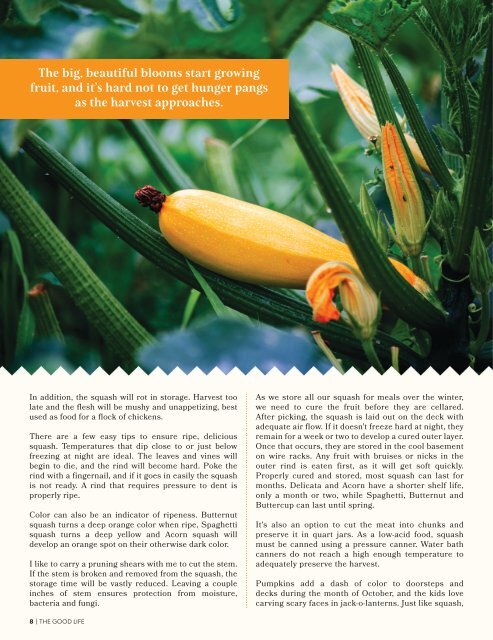The Good Life Magazine – September-October 2023
On the cover – Veterans Honor Flight of North Dakota / Minnesota. Also in this issue, the Changing Roles of Dad’s in Modern Parenting, Life Lessons with Fargo Police Captain and Local Hero Bill Ahlfeldt, How to Find the Perfect Squash and Pumpkin and more!
On the cover – Veterans Honor Flight of North Dakota / Minnesota. Also in this issue, the Changing Roles of Dad’s in Modern Parenting, Life Lessons with Fargo Police Captain and Local Hero Bill Ahlfeldt, How to Find the Perfect Squash and Pumpkin and more!
Create successful ePaper yourself
Turn your PDF publications into a flip-book with our unique Google optimized e-Paper software.
<strong>The</strong> big, beautiful blooms start growing<br />
fruit, and it’s hard not to get hunger pangs<br />
as the harvest approaches.<br />
In addition, the squash will rot in storage. Harvest too<br />
late and the flesh will be mushy and unappetizing, best<br />
used as food for a flock of chickens.<br />
<strong>The</strong>re are a few easy tips to ensure ripe, delicious<br />
squash. Temperatures that dip close to or just below<br />
freezing at night are ideal. <strong>The</strong> leaves and vines will<br />
begin to die, and the rind will become hard. Poke the<br />
rind with a fingernail, and if it goes in easily the squash<br />
is not ready. A rind that requires pressure to dent is<br />
properly ripe.<br />
Color can also be an indicator of ripeness. Butternut<br />
squash turns a deep orange color when ripe, Spaghetti<br />
squash turns a deep yellow and Acorn squash will<br />
develop an orange spot on their otherwise dark color.<br />
I like to carry a pruning shears with me to cut the stem.<br />
If the stem is broken and removed from the squash, the<br />
storage time will be vastly reduced. Leaving a couple<br />
inches of stem ensures protection from moisture,<br />
bacteria and fungi.<br />
As we store all our squash for meals over the winter,<br />
we need to cure the fruit before they are cellared.<br />
After picking, the squash is laid out on the deck with<br />
adequate air flow. If it doesn’t freeze hard at night, they<br />
remain for a week or two to develop a cured outer layer.<br />
Once that occurs, they are stored in the cool basement<br />
on wire racks. Any fruit with bruises or nicks in the<br />
outer rind is eaten first, as it will get soft quickly.<br />
Properly cured and stored, most squash can last for<br />
months. Delicata and Acorn have a shorter shelf life,<br />
only a month or two, while Spaghetti, Butternut and<br />
Buttercup can last until spring.<br />
It's also an option to cut the meat into chunks and<br />
preserve it in quart jars. As a low-acid food, squash<br />
must be canned using a pressure canner. Water bath<br />
canners do not reach a high enough temperature to<br />
adequately preserve the harvest.<br />
Pumpkins add a dash of color to doorsteps and<br />
decks during the month of <strong>October</strong>, and the kids love<br />
carving scary faces in jack-o-lanterns. Just like squash,<br />
8 | THE GOOD LIFE

















